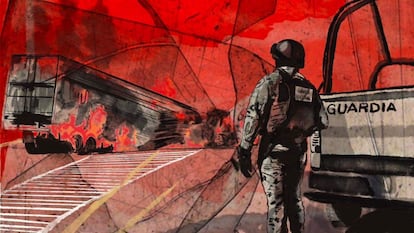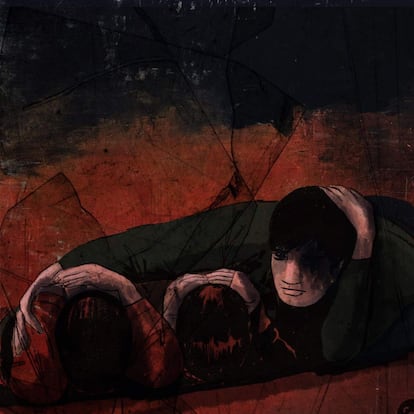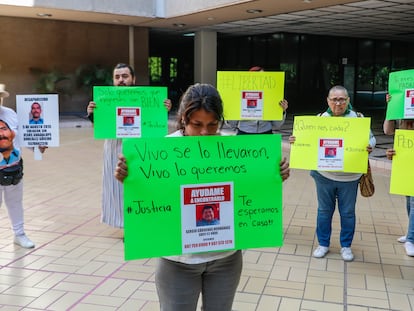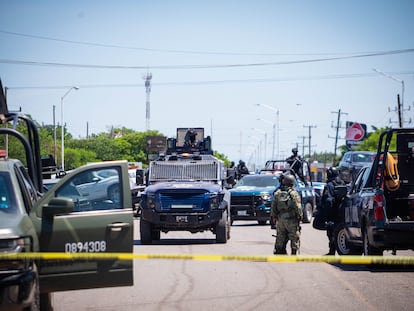The psychological war in Sinaloa: ‘I’ve never felt so sad and hopeless’
The battle between El Mayo and Los Chapitos has resulted in over 300 murders and hundreds of forced disappearances, but the effects go beyond the visible: the lasting scars on mental health after two months of unrelenting violence

It was a normal day. Diana, 30, woke up early to go to work, leaving her phone on airplane mode, unaware that nothing would be the same after that September 9 in Culiacán, the capital of Sinaloa, in northwestern Mexico. Things had gotten so bad that even conversations at home revolved around it. “It’s ugly out there, what do you think? It’s probably another culiacanazo,” they said, in reference to the outbreak of violence following two attempts to arrest Ovidio Guzmán — the son of the notorious drug trafficker, Joaquín “El Chapo” Guzmán — in 2019 and 2023.
When Diana finally checked her phone, it was flooded with messages from work. “They told me not to come in, that work was canceled because there were explosions all over the city,” she recalls. After a month and a half of rising tension over the capture of Ismael “El Mayo” Zambada in the United States, what everyone had feared came true: the war between El Mayo and Los Chapitos, the two families that have controlled the Sinaloa Cartel for decades.
Two months
The bloody battle for control of Culiacán, the cartel’s historic stronghold, has resulted in nearly 320 murders, along with hundreds of forced disappearances, kidnappings, and robberies, according to official records. But these are not the only consequences of two months of relentless violence. EL PAÍS has collected multiple written testimonies about the other war in Sinaloa: the anguish of not being able to find a family member or friend, the night terrors from witnessing a neighbor’s house being blown up, the constant anxiety of not knowing whether you’ll return home safely.
“Two months,” writes Diana, who asks that her real name not be revealed. “Two months of uncertainty, two months in which anguish has taken hold of me, two months in which things have not calmed down.”
Diana says she struggled to sleep during the first days of the war after learning that an acquaintance had been “kidnapped.” His car was found abandoned hours later, but she heard nothing from him for days. He was mistaken for a hitman and eventually released.
“Culiacán is calm,” Sinaloa Governor Rubén Rocha said during his morning press conference on September 9. But after noon, reports of armed clashes, narco-blockades, and daylight murders started pouring in.
The state capital — stretching from its busiest avenues to its most remote neighborhoods — quickly transformed into a war zone, and daily routines gave way to a new, unnerving reality.
“Most of us culichis [Culiacán residents] are on edge all the time,” says Diana. “The first thing we do when we wake up is check what happened while we were asleep and decide whether it’s safe to go out, or not.” She adds: “Something happens every day, even if they say it isn’t, and the government tries to sell us another story. But those of us who live here know what’s happening.”
“Every day, before 6 p.m., the city goes dark and becomes deserted. How can we return to a hidden ‘normality’?” she asks.

Less than a week after Mexico′s Independence Day celebrations were canceled and the state reached one of its highest peaks of violence, a shooting on September 21 spread fear in the commercial area of Cuatro Ríos. “I heard the shots and saw people running, scared, fearful, in panic,” says Diana.
That weekend, uncertainty gave way to outrage when the family and friends of Juan Carlos Sánchez, a 34-year-old father, reported that he had been mistaken for someone else and shot dead during the clashes. While authorities and the media spoke of a cartel war, the idea that “it could happen to anyone” and that “no one was safe” quickly spread across many sectors of society. Just a month after the Cuatro Ríos shooting, the largest massacre to date was recorded: on October 21, 19 armed civilians were killed in a confrontation with the military.
Anxiety, depression and post-traumatic stress
“The impacts of violence on mental health are very well documented, as is the impact of collective violence, which is the context for narco-violence fits — and what is happening in Sinaloa, Guanajuato, and other states,” explains Rogelio Flores, an academic at the National Autonomous University of Mexico (UNAM). Flores emphasizes that the effects are not limited to direct victims but also affect those who witness the violence, those who hear about it through family and friends, and those who are subject to repeated exposure.
“The problem in Sinaloa is not due to this administration, the past or the one before that, it’s been happening for a long time, it’s deeply ingrained,” says Flores. The war on drugs has been ongoing in Mexico for over 20 years, affecting millions of young people who have only known this reality. In Sinaloa, where the violence has persisted for several decades, entire generations have grown up amid it.
“When news started spreading about the disappearances and murders of innocent people who were in the wrong place at the wrong time, that made me very anxious,” confesses Valeria. “Every time I drive, I get so scared. I always think they’re going to kill me or steal my car,” says the 22-year-old. “Even though I’m medicated, sometimes I feel like I can’t control what I feel.” She compares her current anxiety to what she felt in the early days of the Covid-19 pandemic, a comparison that resonates with many in Culiacán due to the ongoing fear and isolation.
Monday marked nine weeks of war and criminal siege. “I feel like the world is on pause,” laments Victor, 25. “But life around the world does go on, except for the narco-pandemic in Culiacán.”

Flores speaks of an individual dimension (psycho-emotional effects) and a collective dimension (psychosocial effects) to distinguish how and who violence affects. The psychologist highlights three distinct impacts: first, anxiety disorders, characterized by fear, mistrust, and constant worry; second, depressive disorders, where individuals experience paralyzing sadness, withdraw from their social circles, and stop engaging with their communities; and third, post-traumatic stress, which often follows traumatic events such as violent deaths, assaults, or shootings. According to Mexico’s National Health and Nutrition Survey, nearly one in five Sinaloans over the age of 20 (19%) showed symptoms of depression by the end of 2023, before the war began.
“I’ve never felt so sad, lost, and hopeless in my life as I have since this war started,” says Daniela, 20. She shares that her depression resurfaced, and there were days when she couldn’t even get out of bed. The war’s escalation, sparked by the split within the Sinaloa Cartel, revived the haunting memories of the Culiacanazos: violent retaliations by the criminal group following the attempts to capture Ovidio Guzmán. However, the current war has lasted far longer — more than 60 days — compared to the Culiacanazos, which were confined to a single day. Daniela recalls that witnessing the first Culiacanazo left her with lasting post-traumatic stress. “The lesson from all this is that the most important thing now is that my mother comes home safely from work, and that I can make it back from school,” she says.
“A neighbor’s house was broken into, and it was one of the most terrifying things I’ve ever experienced,” says León, 26. “I had night terrors, I couldn’t sleep, I was constantly on edge, very scared, panicked, always alert, waiting for something bad to happen at any moment,” he explains. León is undergoing therapy to address his fears regarding his family, friends, and his own safety. He also feels anger and frustration toward the criminal groups. “A problem between two people has deprived us all of many things. We live in constant insecurity and anxiety,” he laments.
Others, like Óscar, a 20-year-old student, describe how the line between everyday problems and the extreme violence around them has blurred. It’s a constant, daily reality. “Every time I go to Culiacán, it feels like a coin toss: a mugging, a crash, a shooting, the heat, the traffic… I spend two hours at the university,” he says. Óscar describes the feeling of losing something fundamental amid the chaos, explaining that not being able to go out and enjoy life and being young has affected his self-esteem and academic performance. Over time, the growing sense of helplessness and frustration with the violence has turned into exhaustion, pushing him to consider leaving Sinaloa in search of a life where he doesn’t feel in constant danger.

“Violence has a different impact,” says Flores, explaining that there is an ongoing debate about what factors lead to varying responses. He cautions against “pathologizing” violent events or entire societies, warning against assuming that everyone is affected in the same way. “We react based on our history, the context in which we grew up, the character and personality traits we have, and all of that shapes one response or another,” he continues. “Some people never develop symptoms of anxiety, depression, or post-traumatic stress,” he adds. “Talking about collective psychosis is excessive; it needs to be analyzed on a case-by-case basis.”
Turning a blind eye
“In the face of chronic violence, when exposed repeatedly, something paradoxical happens: the process of desensitization,” explains Flores, referring to the phenomenon known as the normalization of violence.
Mauricio Meschoulam, an international relations expert who has studied criminal group tactics for almost 15 years, told EL PAÍS that this desensitization also affects the perpetrators, leading to a more sophisticated and cruel method of exercising violence. “There is a communication strategy; it’s not just about committing violence, but using it to generate psychosocial effects: hopelessness, frustration, doubts about who the government really is, and the message that they are the ones in charge in certain areas,” he comments.
Over the past two months, Sinaloa has witnessed increasingly disturbing tactics. Corpses have been found with hats, children’s toys, or messages placed on them to intimidate rivals and authorities. Plastic guns have been left outside El Debate, one of the most well-known local media outlets. While the debate over whether the term “narcoterrorism” is appropriate continues, experts agree that these acts are strategies meant to instill fear in a population that thought they had seen it all, but now witness how violence has spiraled even further, with no consequences. According to the think tank Mexico Evalúa, 99 out of every 100 murders in Sinaloa go unpunished.
Impunity means the costs of frightening the population is relatively low, while the costs of confronting or reporting violence remain extremely high. In these situations, people often choose to turn a blind eye to move forward. “It is very distressing to see the news of what’s happening in the streets,” says 19-year-old Jazmín. “I really try not to look at it, but there are times when you can’t avoid seeing it on social media. Every time I read a news story, it makes me feel very insecure.”

Given the prevailing stigmas, many people lack access to effective resources for dealing with their problems and are instead confronted with “textbook answers” or easy solutions. “They tell you: ‘Relax, breathe, approach things differently,’” says Flores. “What good will that do you if the objective conditions don’t change and are hostile? We are facing a structural problem. We need to talk about inequalities, the root causes of violence, and the need to improve police forces,” he explains. “There can be no mental health without social justice.”
Most people who spoke to EL PAÍS said that what they wanted most was to “return to normality.” Caught in the crossfire, the population wonders when the conflict will end and whether it will ever truly be resolved. In the meantime, another war is spreading across Sinaloa: one marked by uncertainty, fear, and hopelessness.
Sign up for our weekly newsletter to get more English-language news coverage from EL PAÍS USA Edition
Tu suscripción se está usando en otro dispositivo
¿Quieres añadir otro usuario a tu suscripción?
Si continúas leyendo en este dispositivo, no se podrá leer en el otro.
FlechaTu suscripción se está usando en otro dispositivo y solo puedes acceder a EL PAÍS desde un dispositivo a la vez.
Si quieres compartir tu cuenta, cambia tu suscripción a la modalidad Premium, así podrás añadir otro usuario. Cada uno accederá con su propia cuenta de email, lo que os permitirá personalizar vuestra experiencia en EL PAÍS.
¿Tienes una suscripción de empresa? Accede aquí para contratar más cuentas.
En el caso de no saber quién está usando tu cuenta, te recomendamos cambiar tu contraseña aquí.
Si decides continuar compartiendo tu cuenta, este mensaje se mostrará en tu dispositivo y en el de la otra persona que está usando tu cuenta de forma indefinida, afectando a tu experiencia de lectura. Puedes consultar aquí los términos y condiciones de la suscripción digital.
More information
Archived In
Últimas noticias
Most viewed
- Reinhard Genzel, Nobel laureate in physics: ‘One-minute videos will never give you the truth’
- Oona Chaplin: ‘I told James Cameron that I was living in a treehouse and starting a permaculture project with a friend’
- Pablo Escobar’s hippos: A serious environmental problem, 40 years on
- Charles Dubouloz, mountaineering star, retires at 36 with a farewell tour inspired by Walter Bonatti
- Why we lost the habit of sleeping in two segments and how that changed our sense of time











































